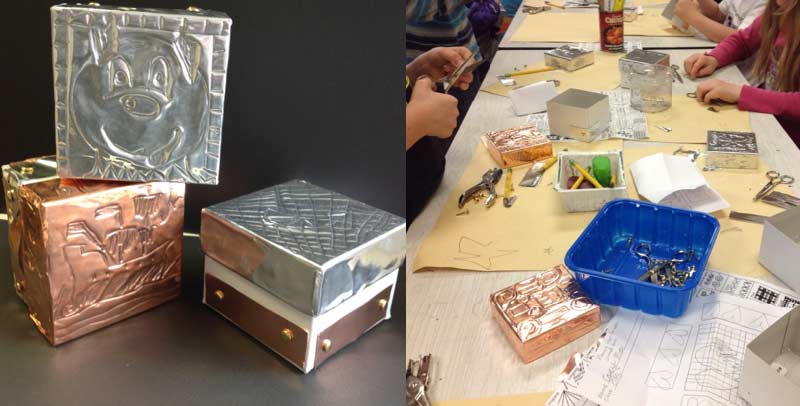Make a Prototype
Become Industrial Designers that create Prototypes for a new product. They each design and create a metal relief box top for packaging a robot from their imagination. This process fosters creativity and builds understanding of art and industrial design concepts.

SCHOOL: Grant Street
TEACHING ARTIST: Lynn Anju
GRADE: 6-8
Lesson: Become Industrial Designers that create Prototypes for a new product. They each design and create a metal relief box top for packaging a robot from their imagination. This process fosters creativity and builds understanding of art and industrial design concepts.
Student:
Target Learning: Understands what a prototype is.
Criteria: Describes how working models are needed for industry to manufacture a product for the masses.
Target Learning: Uses a design process.
Criteria: Creates and practices box top designs on paper that reflect what the robot does before impressing into the metal.
Target Learning: Uses good craftsmanship to produce a metal clad box top in relief.
Criteria: Carefully folds the metal to cover recycled box top, refers to design process page to impress a textural design into the metal with a dull pencil.
Concept Introduced: Industrial Designers are one of many kinds of working artists. They make prototypes for industry: working models of products for the masses. Industry needs designs and models in order to manufacture products. For the period of this class, the room will become an Industrial Design Studio.
Vocabulary
Craftsmanship
Design process
Ergonomics
Impress
Indent
Industrial design
Pattern
Prototype
Recycle
Relief
Texture
Materials
Small to medium recycled box
Thin sheet 40 gauge aluminum or copper (cut to size 1/2 larger than the box on all sides)
Dull pencil
Paper for design
Resources
raymondloewy.org
store.alessi.com/Michael-Graves
nolenniu.com
Patricia Urquiola
Taylor Scott Ross
Teacher and students are Industrial Designers creating a Prototype of packaging for a new product. The product is a robot. It’s ready to be packaged and be sold in stores. The product we design in this case, is packaging for that robot.
Lesson Steps:
Discuss the many fields in which Industrial Designers work. They design; products and packaging (hair dryers, computers, seating, bicycles...); all kinds of transportation; exhibits for museums...etc.
Explain what a prototype is. Help students see the connection between a product that is purchased and the first prototype made of it. This is what is needed for mass production. This would be a great place to introduce examples of prototypes by various Industrial Designers.
Guide students in visualizing the robot they are designing packaging for. The students never need to see this robot but they need to know that it fits perfectly in the box they are using. Each student decides the function of the robot they are designing packaging for: Robots could feed bugs; lock up houses; fly through space; feed fish...etc. The box top design reflects what the robot does.
Remind students of design elements they can choose from to create their design for their unique Robot’s packaging (line, shapes, pattern)
Demonstrate how to handle the metal, being careful of sharp edges, and using good craftsmanship to fold the metal carefully onto the box top. Reiterate good craftsmanship as you demonstrate impressing a design into the metal covered box top with a dull pencil to create a textural design in relief.
Assessment: Reflection Questions
Why is a prototype made?
How is the function of your imagined robot depicted in the packing design?
Identify and describe examples of good craftsmanship and effective use of tools in your own and other’s work.
Extra:
—Lesson can be expanded to add metal to the sides and corners of the recycled box.
—Math can be used for older students to measure and cut their own to fit their box. (1/2 inch needs to be added all sides of the box. Corners need to be cut out.)
Washington State Arts Standards: Visual Arts
Creating: Generate and conceptualize artistic ideas and works. Performance Standard (VA:Cr1.1.2)
a. Brainstorm collaboratively multiple approaches to an art or design problem.
2.3 Creating: Organize and develop artistic works. Performance Standard (VA:Cr2.3.2)
a. Repurpose objects to make something new.
7.2 Responding: Perceive. Performance Standard (VA:Re7.2.4)
a. Analyze components in visual imagery that convey messages
